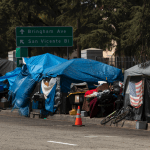Introduction
As we step into 2024, the issue of homelessness continues to be a pressing concern that cannot be overlooked. The numbers, stark and rising, paint a picture that demands not just our attention but our action. I’ve seen firsthand the faces behind these statistics — each one with a story, a struggle, a hope. It’s through these experiences that the Homeless No More program was born, a mission close to my heart, focusing on not just offering shelter, but a path to recovery and a future.
01. Homeless People — The Current Landscape
In America today, the landscape of homelessness is more complex than ever. It’s not just about the lack of a roof over one’s head. We’re talking about the personal traumas, the societal impacts, and the cyclical nature of poverty and despair that keep people trapped in this situation. As someone who’s been working with the homeless for over three decades, I’ve seen how this crisis doesn’t just affect the individuals living on the streets — it ripples through families, communities, and ultimately, our nation.
Bob Sweeney’s Insight
I firmly believe that the solution to homelessness is closer to home than we often realize. It’s about more than just giving; it’s about action. Every one of us has the power to make a difference. Ask yourself, “What can I do to make my community a better place for everyone?” It’s not just about addressing homelessness — it’s about building a society where every person has the opportunity to live a dignified life.
Choose To Make A Difference In Your Community
I invite each of you to reflect on what actions you can take in your communities. Whether it’s volunteering at a local shelter, donating essentials, or simply lending an ear to someone’s story, your contribution matters. Let’s not just be witnesses to change; let’s be the ones who initiate it.
02. Homelessness Statistics in America and Globally
As we sit down and look at the numbers, it’s clear that homelessness is not just a backdrop issue in our society; it’s a glaring headline. The latest figures from 2023 reveal a truth that we can’t ignore: 653,104 souls were without a home during the Point-in-Time Count. Think about that number for a moment. That’s the highest it’s been since we started keeping track in 2007, according to the folks at the National Alliance to End Homelessness. We’re looking at a 12% jump from just the year before (“HUD Releases 2023 AHAR Data: 12 Key Data Points to Understand the Current State of Homelessness in America”). It’s not just in the big cities either; this crisis is spreading its roots in rural and suburban communities as well, with 64% of Continuums of Care reporting increases in unsheltered homelessness.
But let’s talk about people, not just percentages. Among these folks, there’s a startling number of older adults – those 55 and over – making up almost half of the unsheltered. And the states? Well, California’s bearing a heavy load with 181,399 individuals without a home. The District of Columbia, though, has the most pronounced issue per capita, and New York isn’t far behind on that front (“Homelessness in America: Statistics, Analysis, & Trends”).
Globally, the story is much the same, though pinning down exact numbers is tricky due to different countries having different ways of counting. But make no mistake, it’s a worldwide issue affecting millions.
Bob Sweeney’s Insight
Now, let’s pause and think about what these numbers really mean. Every single digit in these statistics represents a human being with a story, a life, a set of dreams, and often, a series of unfortunate circumstances. Having walked alongside many who are homeless, I can tell you that each person’s journey to the streets is as unique as they are. These statistics are a sobering reminder that homelessness isn’t just a problem to be solved – it’s a call to action to see the humanity behind the numbers. We need to remember that behind every statistic is a face, a name, and a story that matters.
So, as we sift through these statistics, let’s not forget that we’re talking about people – our neighbors, friends, and members of our community. The need for compassionate, effective solutions has never been greater. It’s about understanding the individual stories behind the numbers and responding with our hearts and hands.
Get Homeless No More for Your Shelter, Non-Profit or Business.
03. Causes and Trends of Homelessness
In exploring the causes and trends of homelessness, it becomes clear that this issue is not over-arching; rather, it is a complex web of interrelated factors, each contributing to the ever-evolving landscape of homelessness across the nation. As we delve into this analysis, it’s crucial to understand that addressing homelessness requires more than just a temporary fix; it demands a commitment to tackling the root causes and implementing long-term solutions.
Root Causes of Homelessness
The journey into homelessness often begins with systemic socio-economic issues. At the forefront is the scarcity of affordable housing. As housing costs continue to rise, low-income families and individuals are increasingly unable to afford stable housing. This issue is compounded by stagnant wages and unemployment, leaving many just a paycheck away from homelessness.
Mental health and substance abuse are also significant contributors. Without adequate access to mental health care and support services, individuals struggling with these issues are at a higher risk of finding themselves without shelter. Moreover, the criminal justice system plays a role, with the cycle of incarceration and re-entry into society often leading to housing instability.
Supporting Statistics
The statistics paint a vivid picture of the homelessness crisis. According to the National Alliance to End Homelessness, on any given night, hundreds of thousands of people are homeless in the United States, reflecting the magnitude of this issue. This includes individuals, families, veterans, and youth, each group facing unique challenges that contribute to their homelessness.
Trends in Homelessness
Recent trends have shown fluctuations in homelessness rates, with certain regions experiencing increases due to economic pressures, lack of affordable housing, and the impacts of the COVID-19 pandemic. The pandemic, in particular, has exacerbated existing inequalities, pushing more people into precarious housing situations. Additionally, homelessness is becoming more visible in urban areas, challenging communities to find compassionate and effective solutions.
Bob Sweeney’s Insight on Long-term Solutions
Echoing the wisdom of my years in this field, I’ve come to recognize that while emergency services are vital, they are not a remedy. We must look beyond the immediate symptoms of homelessness and address its underlying causes. This means advocating for policies that ensure access to affordable housing, supporting living wage initiatives, and enhancing mental health and substance abuse services.
Investing in education and job training programs is also crucial, empowering individuals with the skills needed to achieve economic stability. Furthermore, reforming the criminal justice system to prevent the cycle of incarceration and homelessness is essential for creating a more equitable society.
In conclusion, the path to eradicating homelessness is multifaceted and challenging. It requires a concerted effort from government agencies, non-profits, communities, and individuals, all working together towards a common goal. By focusing on long-term solutions that address the root causes of homelessness, we can make significant strides towards creating a future where everyone has a place to call home.
Get Homeless No More for Your Shelter, Non-Profit or Business.
04. The Increasing Challenge of Homelessness
In recent years, we’ve witnessed a troubling trend: homelessness is on the rise in the United States. This increase is underscored by recent data, which reveal a complex interplay of factors contributing to the growing challenge of homelessness across the nation. As we delve into this issue, it’s imperative to recognize that combatting homelessness requires a sustained commitment and a focus on long-term planning, principles that have guided my work and advocacy for decades.
Homelessness by the Numbers
- Geographical Hotspots: The problem is particularly acute in populous states like California and New York, which together account for a significant portion of the homeless population in the United States. California, with its high housing costs, has the largest homeless population, while New York City and Los Angeles alone comprise nearly one-quarter of all homeless individuals in the country.
- Demographic Disparities: The rise in homelessness has not been uniform across all populations. Veterans, families with children, and racial and ethnic minorities, particularly Black and Hispanic/Latino communities, have been disproportionately affected. Such disparities necessitate targeted interventions to address the specific needs of these groups.
Bob Sweeney’s Insight on Long-term Solutions
The data underscores the critical need for a sustained commitment to not only address the immediate needs of those experiencing homelessness but also to tackle the underlying causes. Long-term planning, encompassing affordable housing initiatives, comprehensive healthcare services, and support systems, is crucial. It’s not enough to offer temporary shelter; we must strive for solutions that provide stability and dignity, paving the way for individuals to rebuild their lives.
As we consider the path forward, it’s essential to recognize that homelessness is a complex issue that requires a multifaceted approach. Efforts such as the “Housing First” model, which prioritizes providing permanent housing to people experiencing homelessness, have shown promise. However, such initiatives need to be part of a broader strategy that includes access to healthcare, mental health services, job training, and education.
The increasing challenge of homelessness in America calls for a united response, one that leverages the strengths of government, non-profits, communities, and individuals. By committing to long-term planning and sustained efforts, we can make significant strides in addressing this crisis. Together, we can work towards a future where homelessness is not a defining feature of our society, but rather, a challenge that we have overcome through compassion, innovation, and collective action.
For further insights and data on the rise of homelessness and the strategies needed to address it, refer to the National Alliance to End Homelessness, Security.org, and insights from the Harvard Gazette.
05. Life at Homeless No More — A Journey of Recovery
“Life at Homeless No More — A Journey of Recovery” embodies a holistic approach to addressing the root causes of homelessness through a structured, phased program designed to offer more than just shelter. The foundation of our work at Homeless No More is built upon understanding that homelessness is a multifaceted issue, requiring solutions that go beyond immediate needs to address the underlying factors contributing to an individual’s or family’s situation.
Phases of the Homeless No More Program
The Homeless No More program is structured in several phases, each tailored to meet individuals where they are in their journey toward recovery and independence.
- Emergency Response and Stabilization: The initial phase focuses on providing immediate shelter and safety to individuals and families in crisis. This critical first step ensures that basic needs are met, allowing participants to focus on their path to recovery without the looming stress of homelessness.
- Assessment and Personalized Planning: Participants undergo a comprehensive assessment to identify their specific needs, challenges, and strengths. Based on this assessment, a personalized recovery plan is developed, outlining the steps and support required to achieve stable, independent living.
- Skill Building and Employment Preparation: This phase emphasizes the development of essential life and job skills. From financial literacy to job readiness programs, participants are equipped with the tools necessary to succeed in the workforce. Part-time employment opportunities are introduced as a crucial step towards self-sufficiency, providing not only financial stability but also a sense of purpose and community.
- Spiritual Nourishment and Personal Growth: Recognizing the importance of spiritual well-being in the recovery process, the program offers resources for spiritual nourishment, including counseling and access to faith-based services. This aspect of the program supports inner healing and personal growth, essential components of long-term recovery.
- Rebuilding Familial Relationships: Central to the recovery journey is the restoration of broken familial ties. The program offers counseling and support services aimed at rebuilding trust, improving communication, and resolving conflicts within families. Strengthening these relationships is pivotal in creating a stable support network for participants.
Bob Sweeney’s Insight
The significance of part-time employment, spiritual nourishment, and rebuilding familial relationships in recovery cannot be overstated. These elements are interwoven into the fabric of Homeless No More, reflecting our understanding that true recovery encompasses economic stability, emotional healing, and strong community and family connections.
Part-time employment offers a bridge to the workforce, instilling confidence and a sense of achievement. Spiritual nourishment addresses the soul’s needs, providing hope and strength to face challenges. Lastly, the focus on familial relationships ensures a support system that is crucial for long-term success and happiness.
Get Homeless No More for Your Shelter, Non-Profit or Business.
06. The Role of Spirituality and Community in Recovery
In our journey through the intricate process of recovery at Homeless No More, spirituality and community emerge not merely as aspects of the program but as its very pillars. These elements transcend the basic needs of shelter and sustenance, touching the core of what it means to rebuild a life from the shadows of homelessness. Drawing from decades of experience and the profound stories of those we’ve had the honor to assist, it becomes clear that the path to recovery is as much about the heart and spirit as it is about physical and economic restoration.
The Role of Spirituality in Recovery
Spirituality, in the context of Homeless No More, is understood in its broadest sense: a quest for meaning, purpose, and connection that transcends individual circumstances. It is about finding one’s place in the universe and understanding the intrinsic value of life. This search for meaning is crucial in the recovery process, offering a foundation of hope and resilience.
Discipleship and righteousness stand at the core of our spiritual framework, guiding participants toward a life marked by ethical living, compassion, and self-discipline. Discipleship involves mentoring and guidance, not only in matters of faith but in the practical aspects of living a life aligned with one’s values. Righteousness, then, is the pursuit of a life that reflects these values, characterized by fairness, integrity, and a commitment to doing what is right.
The Importance of Community Support
The role of community in recovery cannot be overstated. Community support provides a network of care, encouragement, and practical assistance that is indispensable in overcoming the challenges of homelessness. It is within the community that individuals find strength in times of weakness, acceptance in the face of judgment, and companionship in moments of loneliness.
Community support at Homeless No More manifests in various forms, from group counseling sessions and shared meals to volunteer opportunities and community outreach programs. Each of these interactions reinforces the idea that recovery is not a solitary journey but a communal endeavor, where each member plays a vital role in the healing of others.
Bob Sweeney’s Insight
From my years of service, I’ve observed that discipleship, righteousness, and community support are not just components of the recovery process; they are its very essence. They foster an environment where individuals are not defined by their past but are seen for their potential to grow, contribute, and thrive. This environment encourages participants to envision a future where they are not only self-sufficient but are also active contributors to the welfare of others.
The synergy of spirituality and community in recovery teaches us that while homelessness might strip away material possessions, it cannot diminish the human spirit’s capacity for hope, transformation, and renewal. It is this spirit that Homeless No More seeks to nurture, guided by the principles of discipleship and righteousness, and supported by the strength of our community.
In conclusion, the journey of recovery at Homeless No More is a testament to the transformative power of spirituality and community. As we continue to support individuals on this path, we are reminded of the profound impact of these pillars in not just overcoming homelessness but in fostering a life of purpose, dignity, and service to others.
07: How to Support the Homeless – Practical Tips
Supporting the homeless community is a multifaceted endeavor that requires compassion, understanding, and proactive engagement. In our work at Homeless No More, we’ve seen the transformative impact of individual actions on the lives of those experiencing homelessness. Here are practical ways you can make a difference, coupled with a call to action that echoes the core of our mission.
Practical Tips to Support the Homeless
- Educate Yourself and Others: Understanding the root causes of homelessness is the first step toward making a meaningful difference. Educate yourself about the complexities of homelessness, including economic factors, health issues, and systemic barriers. Share this knowledge with your community to dispel myths and foster empathy.
- Volunteer Your Time: Local shelters and programs like Homeless No More are often in need of volunteers. Whether it’s serving meals, offering skills training, or providing administrative support, your time is a valuable asset that can significantly impact the lives of those in need.
- Mentor and Advocate: Consider becoming a mentor to individuals transitioning out of homelessness. Offering guidance, support, and encouragement can be incredibly empowering for someone working to rebuild their life. Additionally, advocate for policies and initiatives that address homelessness at its root, promoting affordable housing, healthcare access, and employment opportunities.
- Donate Necessities and Financial Support: Donations of clothing, toiletries, and other essentials are always needed at shelters and outreach programs. Financial contributions, meanwhile, enable organizations to continue their vital work, fund housing projects, and expand their services.
- Engage in Respectful Interactions: Treat individuals experiencing homelessness with dignity and respect. A simple smile or conversation can offer a sense of normalcy and human connection that is often missing in their lives.
Volunteer, Mentor, or Donate to Homeless No More
We invite you to join us in our mission to combat homelessness by volunteering your time, becoming a mentor, or making a donation to Homeless No More. Your involvement can take many forms, from hands-on assistance within our programs to advocacy and financial support. Together, we can provide the resources, support, and care necessary for individuals and families to transition from homelessness to stability and independence.
By engaging with our program, you’re not just offering temporary relief but contributing to a sustainable solution that addresses homelessness at its core. Whether it’s through mentorship that guides individuals towards personal and professional growth, or donations that help us expand our reach and impact, your support is invaluable.
Let’s unite in the spirit of compassion and action to make a tangible difference in the lives of those experiencing homelessness. Your involvement can light the path to recovery and hope for many.
Conclusion
As we conclude our exploration of the multifaceted issue of homelessness and the transformative journey offered by Homeless No More, it’s crucial to revisit and underscore the pivotal insights and calls to action that have been shared. The growing challenge of homelessness, accentuated by recent data, demands not only our attention but also our concerted efforts and compassion. This crisis, as we’ve discussed, is not insurmountable, provided we come together as a community, informed and motivated by a shared sense of collective responsibility.
Key Points Reiterated
- The Complexity of Homelessness: Homelessness is a complex issue, driven by a confluence of factors including economic instability, lack of affordable housing, and systemic barriers. Understanding these root causes is essential for effective intervention.
- The Role of Homeless No More: Through a phased approach that addresses immediate needs and fosters long-term stability, Homeless No More exemplifies how structured support can significantly alter the trajectory of those it serves.
- The Importance of Spirituality and Community: Spirituality and community are not ancillary but central to the recovery process, offering the emotional and social scaffolding necessary for true healing and reintegration.
In our shared exploration today, we’ve delved deep into the heart of homelessness, uncovering its roots, challenges, and the beacon of hope programs like Homeless No More provide. As we draw our discussion to a close, let’s crystallize the essential truths we’ve encountered, guided by a spirit of collective responsibility and a firm belief in the transformative power of individual actions.
Homelessness: A Growing Challenge
The challenge of homelessness continues to escalate, fueled by an amalgamation of economic disparity, housing instability, and systemic barriers. Our journey through the narratives of those affected and the insights into programs designed to aid them underscores the urgency of this crisis. It’s a reminder that behind every statistic lies a human story, deserving of dignity, support, and a path to recovery.
Bob Sweeney’s Insight on Collective Responsibility
The essence of our discussion today, and indeed the core of my lifelong work, centers on a fundamental belief: We are all collectively responsible for addressing the challenges of homelessness. It’s a belief that underscores the notion that within each of us lies the capacity to effectuate profound change. Our actions, no matter how small they may seem, accumulate into waves of transformation that can uplift lives and reshape communities.
Join The Mission
As we conclude, I extend an invitation to each of you to become active participants in the mission against homelessness. Spread awareness about the complexities of homelessness and the impactful work being undertaken by Homeless No More. Awareness is the precursor to action, and by broadening our collective understanding, we lay the groundwork for meaningful change.
But let’s not stop at awareness. I urge you to consider how you might directly contribute to the fight against homelessness. Whether through volunteering, mentoring, or providing financial support to programs like Homeless No More, your involvement can light the way for someone’s journey out of homelessness. It’s through our shared efforts that we can transform the landscape of homelessness from one of despair to one of hope and opportunity.
In closing, let this conversation not be the end, but rather a beginning — a call to arms for all who believe in the power of compassion, community, and collective action. Together, we can confront the challenge of homelessness, offering not just hope, but tangible pathways to recovery and stability. Join us in this mission, and together, let’s make a difference that echoes far beyond our own lifetimes.
References:
- “HUD Releases 2023 AHAR Data: 12 Key Data Points to Understand the Current State of Homelessness in America.” National Alliance to End Homelessness, end homelessness.org.
- “Homelessness in America: Statistics, Analysis, & Trends.” Security.org, security.org.
- National Alliance to End Homelessness. “How to Help Homeless People.” National Alliance to End Homelessness, n.d., https://endhomelessness.org/blog/how-do-communities-use-their-limited-resources-to-help-homeless-people1/.
- “State of Homelessness: 2023 Edition.” National Alliance to End Homelessness, 2024, https://endhomelessness.org/homelessness-in-america/homelessness-statistics/state-of-homelessness/
- “Homelessness in America: Statistics, Analysis, & Trends.” Security.org, 2023, https://www.security.org/resources/homeless-statistics/.
- Koh, Howard. “Why It’s So Hard to End Homelessness in America.” The Harvard Gazette, Harvard University, 26 Jan. 2023, https://news.harvard.edu/gazette/story/2024/01/why-its-so-hard-to-end-homelessness-in-america/
Image by Freepik
0001






